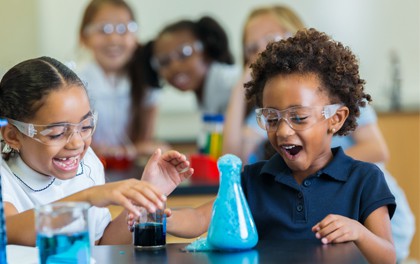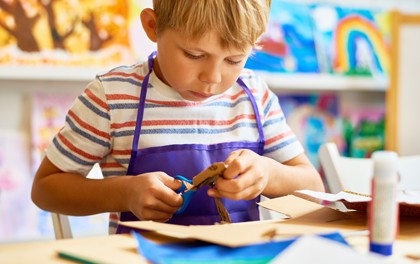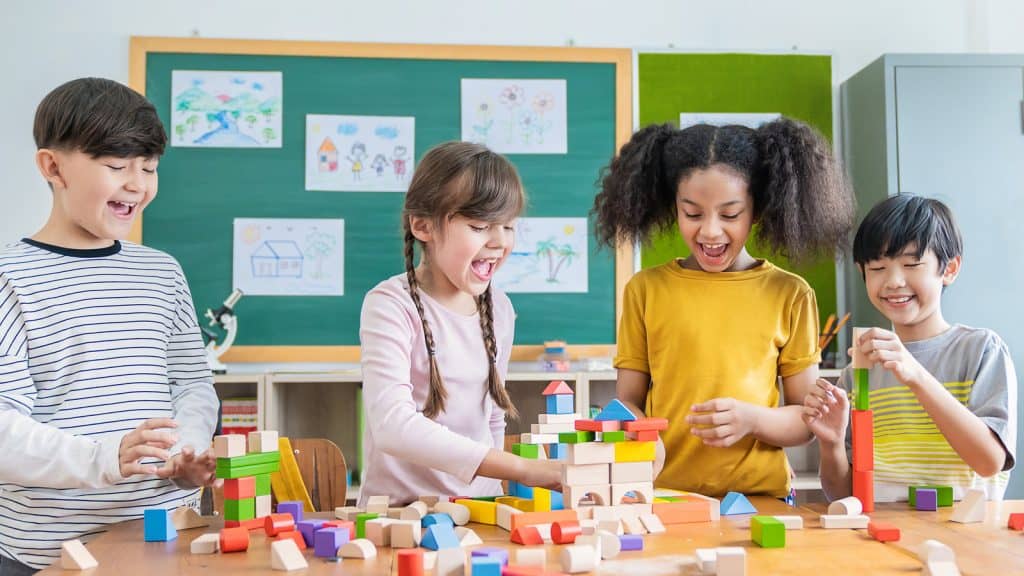Lately, the three Rs of school have been eclipsed by a focus on STEM education, or Science, Technology, Engineering, and Math.
But that doesn’t mean that there’s no room for creativity or the arts in the classroom. On the contrary, creativity is increasingly being recognized as a vital skill for the future.[2] Because of that, and the impact creativity has on learning, fostering creativity should be a natural function of schools.[5]
Read on for a look at why creativity is important and suggestions on how to mix STEM activities and creativity in the classroom.
Why Is Creativity Important for Children in STEM?
Creativity through art and play is important for enriching lives, if for no other reason. But it’s also important for strengthening the mind, and it is among the most important attributes in increasing learning. In fact, creativity is essential to STEM. That’s why you’ll often see an emphasis on STEAM—Science, Technology, Engineering, Arts, and Math.
It’s important not to think of creativity and the arts as separate from STEM fields. Creativity is a core competency in science and is behind many “Eureka!” moments of discovery.[4]
“Researchers have found that play is important for productive thought. Playing with ideas also increases learning,” writes Ainissa Ramirez in Edutopia. “We must encourage playing with concepts to nurture creativity in students.”[3]
“The skills of the 21st century need us to create scholars that can link the unlinkable,” Ramirez continues. “These scholars must be willing to try many combinations before finding the right answer. They must be comfortable with concepts that they can play with in new ways. We want smart-thinking creative people. This is the formula for a better tomorrow.”[3]
Although there’s no sure-fire formula for teaching children how to be more creative, there are ways STEM teachers can encourage students to tap into their creative side.
7 Ways to Encourage Creativity in Science, Technology, Engineering, and Math Classes
During your STEM classes, you can use fun games and other creative activities that will help your students nurture their creativity. Here are some ways you can encourage children’s creativity to merge with STEM.
1. Create a Stimulating Physical Environment
The right kind of environment can help children learn and create. A flexible space that’s inclusive and allows for a variety of arrangements can encourage collaboration, problem-solving, creativity, and communication. Teachers should also embrace the movement of a child. When students have the chance to move, “both their brain and their circulation are refreshed.”[8]
2. Throw a Task Party
A task party lets children think outside the box by completing a creative task in a certain amount of time. Beforehand, gather odds and ends (like paper plates, styrofoam, and cardboard) along with scissors, glue, and other art supplies. On slips of paper, write several tasks or things to build (draw a friend’s portrait, build a house for a mouse, etc.) and place them in a bucket or jar. Have a student pull out a task and get started.[9]
3. Introduce Project Based Learning
Project Based Learning (PBL) makes space for creativity to grow by having students work on a real-world challenge over a period of time. Solving a real-world problem that has no one right answer pushes students to think creatively.[5]
PBL allows students to ask questions, think critically, and apply their academic knowledge to a real-world situation. Teachers take on the role of a facilitator, allowing students to work independently, make their own decisions, and experience independence in solving problems.[7] You can find some more examples on DefinedLearning.com.
4. Combine Maker Activities and STEM Lessons
Children naturally enjoy making things. This also helps them grow their creativity. A makerspace, a place where students can think, imagine, explore ideas together, can help students create and invent while learning STEM fundamentals.[5]
 5. Set Out Art Traps in the Classroom
5. Set Out Art Traps in the Classroom
An art trap is an invitation for students to come create something. You set out all the art or craft supplies your students need to make something and have them at the ready, waiting for a student to pass by.[10]
This helps eliminate the barriers students might encounter that could stop them from creating something. When all the brushes, media, and tools are prepared and easy to access, your students can just jump in and exercise their creative muscles with a medium they might otherwise not have tried.
6. Avoid Creativity Killers
Part of encouraging creativity is knowing things to avoid. Leslie Wilson writes about the creativity killers —things or situations that can squash a child’s natural curiosity—that teachers should be wary of. These include:
- Surveillance: Hovering over children and making them feel watched can cause students to hide their risk-taking urges.
- Evaluation: Constantly making students worry about how they’re doing can cause them to ignore the satisfaction in their own accomplishments.
- Rewards: The excessive use of prizes can deprive a student of the pleasure of creative activity.
- Pressure: Unreasonably high expectations can pressure children to conform and deter exploration and innovation.[6]
7. Embrace Mistakes
Perfectionism is a natural impulse many students may harbor. But perfectionism can also prevent people from finishing tasks, or trying new things. Take action to help your students embrace mistakes and think about failure as an opportunity for growth instead.[11] Here’s why mistakes are good:
- Students learn from their mistakes. It’s an opportunity to grow by analyzing a situation and choosing a different course of action next time.
- Mistakes help students become better problem solvers and critical thinkers. When a student makes a mistake, they learn to develop foresight, critical thinking, and problem-solving skills.
Sources:
- Hughes, Joanna. “STEM, STEAM, and Where Creativity Fits into the Mix.” Keystone Masterstudies. April 2017. https://www.masterstudies.com/article/STEM-STEAM-and-Where-Creativity-Fits-into-the-Mix/
- Van Broekhoven, Kim, David Cropley, and Philipp Seegers. “Differences in Creativity Across Art and STEM Students: We Are More Alike than Unalike.” June 2020. https://www.sciencedirect.com/science/article/pii/S1871187120301814
- Ramirez, Ainissa. “Creativity is the Secret Sauce in STEM.” Edutopia.org. August, 2013. https://www.edutopia.org/blog/creativity-secret-sauce-in-stem-ainissa-ramirez
- Escalante, Alison. “Creativity Education is Equally Important for Careers in STEM and the Arts.” Forbes.com. November 2020. https://www.forbes.com/sites/alisonescalante/2020/11/30/creativity-education-is-equally-important-for-careers-in-stem-and-the-arts/?sh=30524c41554f
- Jolly, Anne. “Cultivate Creativity in Your STEM Classroom.” DefinedLearning.com. https://blog.definedlearning.com/blog/cultivate-creativity-in-your-stem-classroom
- Wilson, Leslie, Ed.D. “Killing or Fostering Creativity in Children.” The Second Principle. https://thesecondprinciple.com/understanding-creativity/children-creativity/killingcreativityinchildren/
- O’Brien, Maggie. “What is Project Based Learning? DefinedLearning.com. https://blog.definedlearning.com/blog/what-is-project-based-learning
- Envision by World Strides. “6 Key Elements of 21st Century Classroom Design.” envisionexperience.com. July 2017. https://www.envisionexperience.com/blog/6-key-elements-of-21st-century-classroom-design
- Harmon, Wynita. “8 Ways to Help Your Students Be More Creative.” The Art of Education. 2019. https://theartofeducation.edu/2019/02/13/8-ways-to-help-your-students-be-more-creative/
- Hathaway, Nan. “Art Trap.” Studio-Learning. December 2017. https://studio-learning.blogspot.com/2017/12/art-trap.html
- Tulsian, Kirsten. “The Truth About Making Mistakes: Helping Students Discover the Benefits.” Kirsten’s Kaboodle. https://kirstenskaboodle.com/the-benefits-of-making-mistakes/

